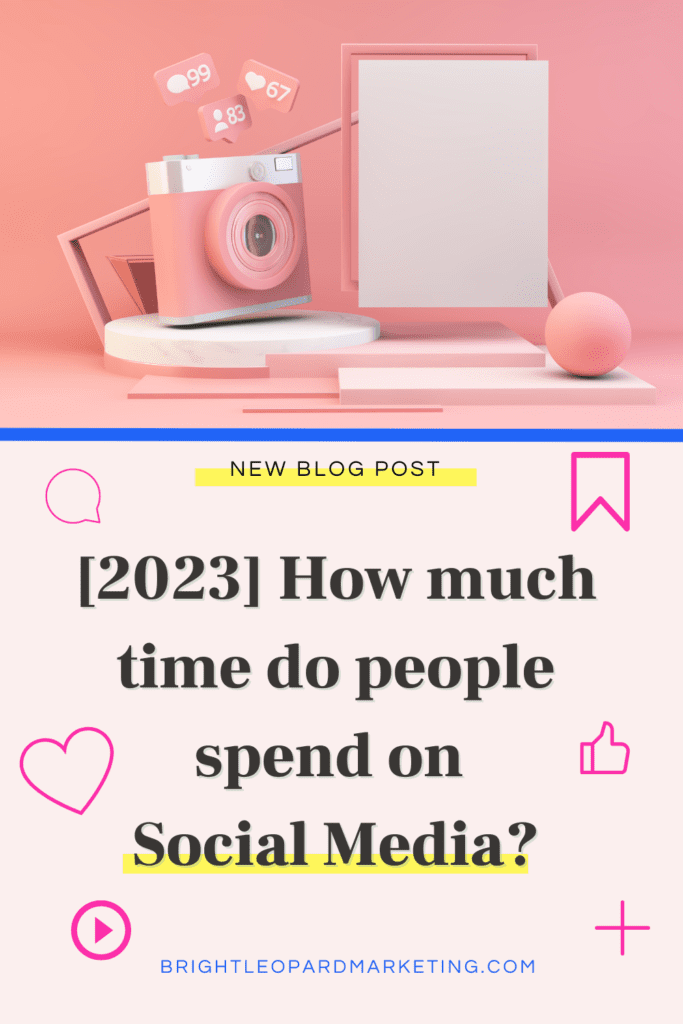Social media is an integral part of our daily lives, and this trend is only increasing. We use it to communicate with loved ones, to stay informed on the latest news and trends, and to stay connected to the world around us. But how much time are people actually spending on social media in 2023? In this blog post, Bright Leopard Marketing explores this question and analyses the data to gain insights into how much time people spend on social media in 2023.
Trends in social media usage
Slowly but surely, the world is recovering from the pandemic that has dominated our lives for the past couple of years. With Covid-19 restrictions easing up, businesses are getting back on their feet – especially sectors which had more restrictions than others. However, there is still a looming chance of recessions (in several countries), mounting inflation, declining consumer spending, and workforce reductions that could significantly impact social media usage in the years to come.
Despite these challenges, social media marketing is still growing in popularity. As more people spend time online, social media marketers get larger slices of the overall marketing budget and more agency over their work. Social media marketing has also matured as a profession, with increasing training courses, certification programs, and tools to help social media marketers do their jobs more effectively.
However, with great power comes great responsibility. Successful social marketers should carefully assess their opportunities and think about the long-term impact of their short-term strategies. By doing so, they can create lasting relationships with their audiences and drive meaningful business results for their clients.
In 2023, social media usage will likely continue to increase, but it’s crucial to note that not all social media platforms are created equal. Some social networks, such as TikTok, Snapchat, and Instagram, have seen significant growth in recent years, while others, like Facebook, have experienced declines in user engagement.
As we move forward, it’s essential to stay on top of emerging trends and continually reassess our social media strategies. By doing so, we can adapt to changing market conditions and make the most of our social media efforts. The future of social media is bright, and those who take the time to establish relationships and build their brand’s reputation will see the positives of harnessing its power.
How much time are people spending on social media in 2023?
In 2022, the average internet user spent 2 hours and 30 minutes per day on social media, and this trend is likely to continue into 2023. However, this average varies greatly among age groups. For example, tweens aged between 8 and 12 had an average daily screen time of 5 hours and 33 minutes, and teens aged between 13 and 18 spent an average of 8 hours and 39 minutes on screens (Tech Jury).
Looking at specific social media platforms, global Facebook users spend an average of 33 minutes each day on the platform, YouTube users spend an average of 19 minutes and 39 seconds daily, TikTok users spend an average of 31 minutes per day, and Instagram users spend an average of 11.7 hours per month. These trends in time spent on social media by age group and gender are expected to continue in 2023.
It’s important to note that the time spent on social media can have negative effects on mental health and well-being, and individual users can vary widely in terms of their social media usage. Despite this, social media remains an incredibly popular activity, with 4.7 billion people using social media in 2022 and 2.91 billion active Facebook users.
According to research, American adults spend an average of 33 minutes per day on Facebook, usually consisting of one longer visit and lots of shorter ones. As we hit the halfway point of 2023, we can expect to see continued use of social media platforms and further entrenchment of these platforms into our daily lives.

Reasons for increased/decreased social media usage in 2023
In 2022, workers aged 16-44 spent an average of 7 hours online every day. However, that figure has since decreased to 6 hours and 37 minutes. This decrease could have a serious impact on B2B brands and the global industry. To understand what is happening, the focus should be on search behaviour.
Interestingly, 16-34-year-olds are turning to social media to learn about brands before making purchases. Having a strong presence across social channels and posting informative content is important for B2B organisations to capture the attention of this demographic.
Furthermore, search engines and social media channels have swapped roles. Instagram, for example, is now used as a buying channel, whereas Google is used to find information. This shift in behaviour can also be attributed to the increasing use of voice assistants.
Overall, understanding these trends and adapting marketing strategies accordingly is crucial for businesses to remain relevant in the ever-changing digital landscape. Social media is still a powerful tool for organisations, but it’s essential to stay informed and adapt to the evolving behaviour of consumers.
Not sure who your ideal client is? Download our Buyer Persona Worksheet.
The future of social media for businesses
The future of social media for businesses is looking bright. With big brands no longer competing for creators, small businesses are now given the opportunity to make their mark on social media. Budgets are on the line as bosses demand social receipts, and as social media gains more investment, it is exposed to new levels of scrutiny.
Marketers are no longer chasing new features and are instead getting more strategic. Creators can help small businesses with their most acute marketing challenges. Despite this, the majority of small businesses do not work with creators yet. But, creators are not as out of reach as people think.
Confidence in the ROI of social media marketing is at an all-time high, and this means more visibility, which, in turn, means more scrutiny. Businesses that want to thrive on social media will need to focus on creating quality content that resonates and connects with their target audience.
The future of social media for businesses is one where small businesses are empowered to create and share content that builds a relationship with their ideal audience. Creators can help these businesses navigate the complexities of social media and reach their goals. With the right approach, social media can be an invaluable tool for businesses looking to grow and engage with their audience.






